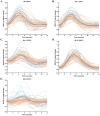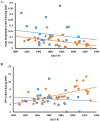Preserved canonicality of the BOLD hemodynamic response reflects healthy cognition: Insights into the healthy brain through the window of Multiple Sclerosis
- PMID: 29454932
- PMCID: PMC6093806
- DOI: 10.1016/j.neuroimage.2017.12.081
Preserved canonicality of the BOLD hemodynamic response reflects healthy cognition: Insights into the healthy brain through the window of Multiple Sclerosis
Abstract
The hemodynamic response function (HRF), a model of brain blood-flow changes in response to neural activity, reflects communication between neurons and the vasculature that supplies these neurons in part by means of glial cell intermediaries (e.g., astrocytes). Intact neural-vascular communication might play a central role in optimal cognitive performance. This hypothesis can be tested by comparing healthy individuals to those with known white-matter damage and impaired performance, as seen in Multiple Sclerosis (MS). Glial cell intermediaries facilitate the ability of neurons to adequately convey metabolic needs to cerebral vasculature for sufficient oxygen and nutrient perfusion. In this study, we isolated measurements of the HRF that could quantify the extent to which white-matter affects neural-vascular coupling and cognitive performance. HRFs were modeled from multiple brain regions during multiple cognitive tasks using piecewise cubic spline functions, an approach that minimized assumptions regarding HRF shape that may not be valid for diseased populations, and were characterized using two shape metrics (peak amplitude and time-to-peak). Peak amplitude was reduced, and time-to-peak was longer, in MS patients relative to healthy controls. Faster time-to-peak was predicted by faster reaction time, suggesting an important role for vasodilatory speed in the physiology underlying processing speed. These results support the hypothesis that intact neural-glial-vascular communication underlies optimal neural and cognitive functioning.
Copyright © 2018 Elsevier Inc. All rights reserved.
Conflict of interest statement
Figures




Similar articles
-
The neurovascular basis of processing speed differences in humans: A model-systems approach using multiple sclerosis.Neuroimage. 2020 Jul 15;215:116812. doi: 10.1016/j.neuroimage.2020.116812. Epub 2020 Apr 8. Neuroimage. 2020. PMID: 32276075
-
Neurovascular Coupling During Visual Stimulation in Multiple Sclerosis: A MEG-fMRI Study.Neuroscience. 2019 Apr 1;403:54-69. doi: 10.1016/j.neuroscience.2018.03.018. Epub 2018 Mar 23. Neuroscience. 2019. PMID: 29580963 Free PMC article.
-
BOLD hemodynamic response function changes significantly with healthy aging.Neuroimage. 2019 Mar;188:198-207. doi: 10.1016/j.neuroimage.2018.12.012. Epub 2018 Dec 6. Neuroimage. 2019. PMID: 30529628 Free PMC article.
-
Structural and Functional MRI Techniques in Multiple Sclerosis Related Cognitive Dysfunction.Folia Med (Plovdiv). 2018 Dec 1;60(4):505-511. doi: 10.2478/folmed-2018-0031. Folia Med (Plovdiv). 2018. PMID: 31188776 Review.
-
Functional MRI and cognition in multiple sclerosis-Where are we now?J Neuroimaging. 2025 Jan-Feb;35(1):e13252. doi: 10.1111/jon.13252. J Neuroimaging. 2025. PMID: 39636088 Free PMC article. Review.
Cited by
-
Cerebrovascular Reactivity and Neurovascular Coupling in Multiple Sclerosis-A Systematic Review.Front Neurol. 2022 Jun 1;13:912828. doi: 10.3389/fneur.2022.912828. eCollection 2022. Front Neurol. 2022. PMID: 35720104 Free PMC article.
-
Higher Dietary Acid Load Might Be a Potent Derivative Factor for Multiple Sclerosis: The Results from a Case-Control Study.Nutrients. 2023 Jul 26;15(15):3311. doi: 10.3390/nu15153311. Nutrients. 2023. PMID: 37571248 Free PMC article.
-
Towards whole brain mapping of the haemodynamic response function.J Cereb Blood Flow Metab. 2025 Apr 12:271678X251325413. doi: 10.1177/0271678X251325413. Online ahead of print. J Cereb Blood Flow Metab. 2025. PMID: 40219926 Free PMC article.
-
Altered linear coupling between stimulus-evoked blood flow and oxygen metabolism in the aging human brain.Cereb Cortex. 2022 Dec 15;33(1):135-151. doi: 10.1093/cercor/bhac057. Cereb Cortex. 2022. PMID: 35388407 Free PMC article.
-
The subtleties of cognitive decline in multiple sclerosis: an exploratory study using hierarchichal cluster analysis of CANTAB results.BMC Neurol. 2018 Sep 10;18(1):140. doi: 10.1186/s12883-018-1141-1. BMC Neurol. 2018. PMID: 30200902 Free PMC article.
References
-
- Abrahams S, Leigh PN, Goldstein LH. Cognitive change in ALS A prospective study. Neurology. 2005;64(7):1222–1226. - PubMed
-
- Ackerman PL, Beier ME, Boyle MD. Individual differences in working memory within a nomological network of cognitive and perceptual speed abilities. Journal of Experimental Psychology: General. 2002;131(4):567. - PubMed
-
- Acosta-Cabronero J, Williams GB, Pengas G, Nestor PJ. Absolute diffusivities define the landscape of white matter degeneration in Alzheimer's disease. Brain. 2010;133(2):529–539. - PubMed
-
- Aguirre GK, Zarahn E, D'Esposito M. The variability of human, BOLD hemodynamic responses. NeuroImage. 1998;8(4):360–369. - PubMed
Publication types
MeSH terms
Grants and funding
LinkOut - more resources
Full Text Sources
Other Literature Sources
Medical

